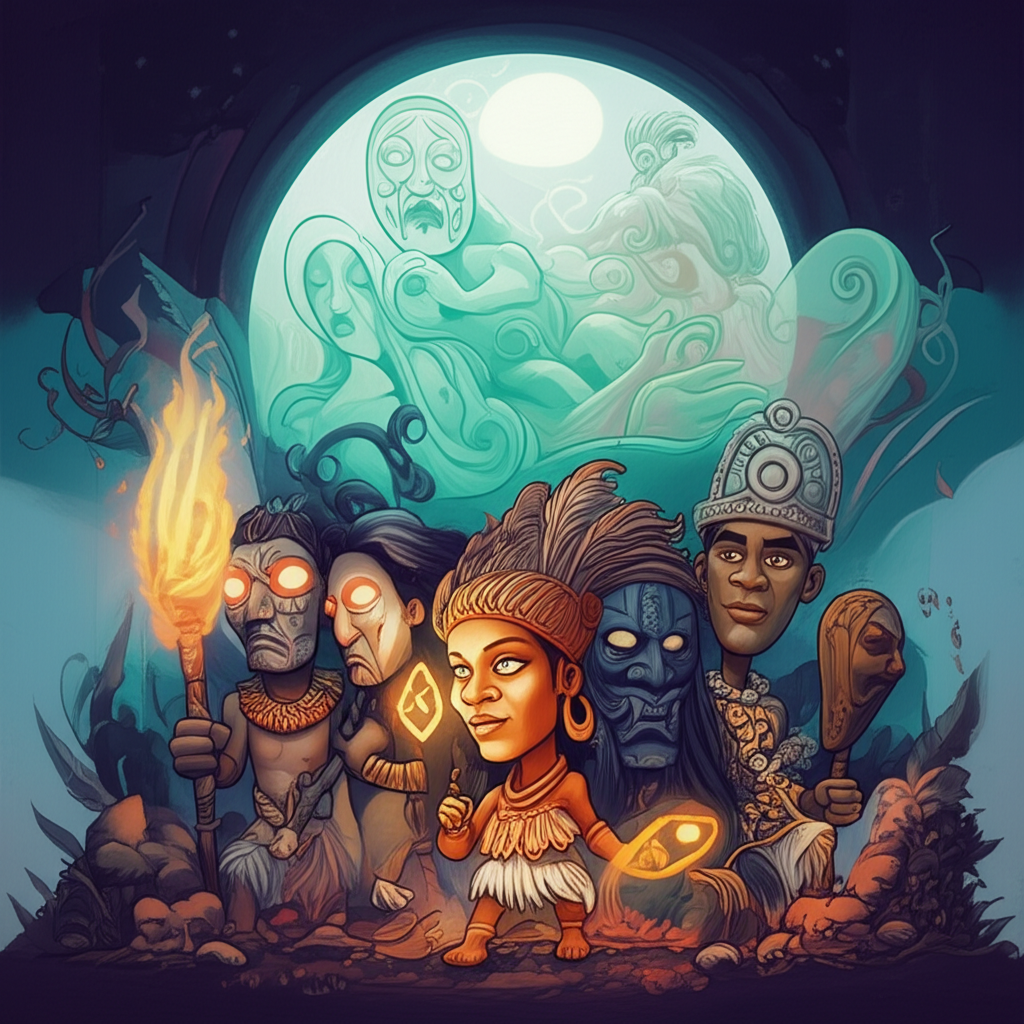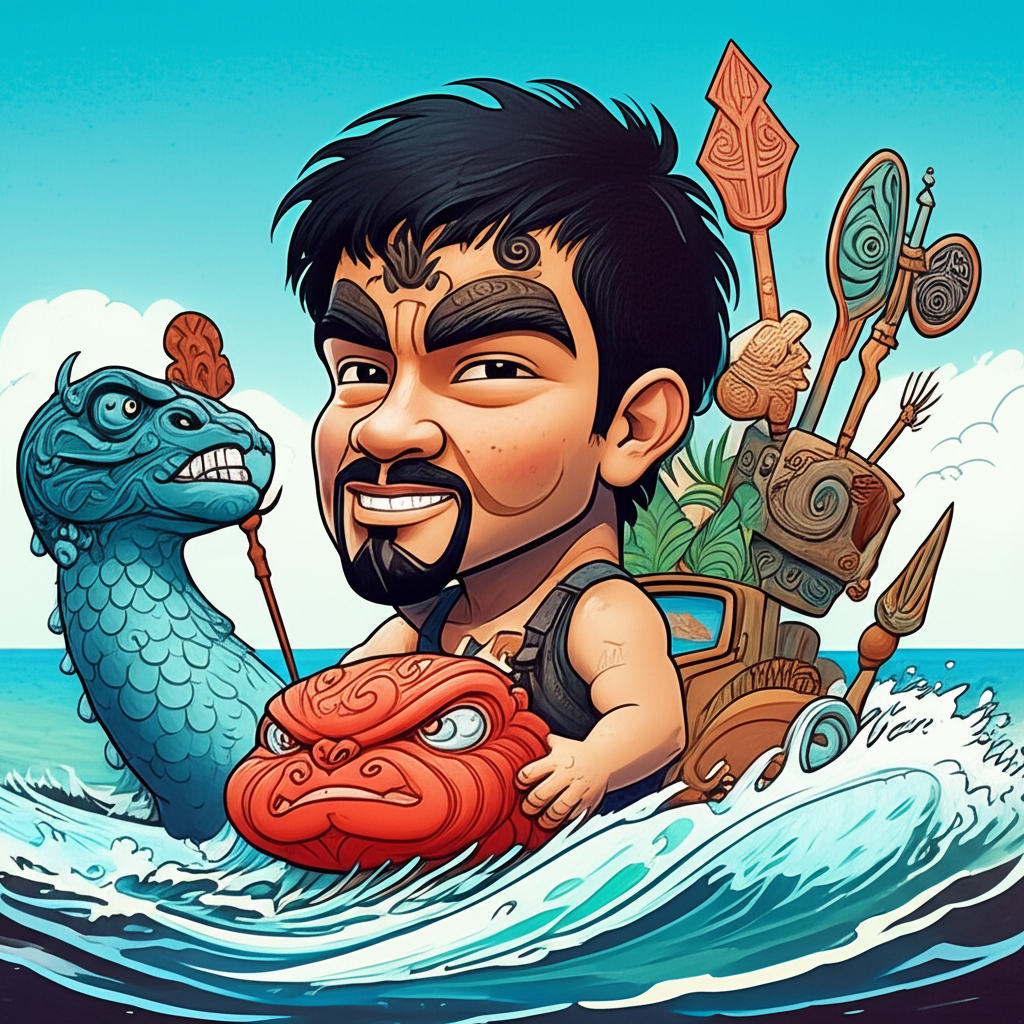
This article explores a fascinating tapestry woven from the ancient myths and legends of Polynesia, particularly drawing from Hawaiian and Māori traditions. The tales of Hina, the spectral Nightmarchers (Huaka’i Po), and the ancestral homeland of Hawaiki represent a rich cultural heritage, passed down through generations. It is crucial to understand from the outset that these are traditional stories, shared by ancient peoples to explain their world and their place within it. They are not real, nor are they meant to be believed, worshipped, or practiced as truth today. Instead, we present this narrative for its profound cultural, historical, and educational value, offering insight into the imaginative depths of a vibrant civilization.
Origins and Cultural Background
The myths surrounding Hina, the Nightmarchers, and Hawaiki emerged from the pre-contact Polynesian societies, an era defined by deep reverence for the ocean, the land (ʻāina), and the cosmos. These island communities, master navigators who traversed vast expanses of the Pacific, developed complex oral traditions that mirrored their intimate connection to their environment. Their worldview was one where the physical and spiritual realms were inextricably linked. The land, the sea, the sky, the plants, and the animals were imbued with spirit (mana) and life force. Ancestors (tupuna in Māori, kūpuna in Hawaiian) were not merely figures of the past but continued to influence the present, their mana flowing through their descendants.
In this animistic framework, deities (atua or akua) personified natural phenomena and essential aspects of existence. The concept of kapu (Hawaiian) or tapu (Māori) defined sacredness, prohibitions, and social order, maintaining harmony between humans, nature, and the divine. Hawaiki, in this context, was more than just a geographical point of origin; it was a spiritual homeland, a place of ancestral memory, and sometimes, the destination for spirits after death. It symbolized the unbroken chain of lineage, identity, and the profound journey of their ancestors across the vast Pacific.
Character / Creature Description
Within this rich mythological landscape, three elements stand out:
-
Hina: In various Polynesian traditions, Hina is a prominent goddess figure, often associated with the moon, craftsmanship (especially tapa making), and sometimes the underworld. Across different islands, her stories vary, but she consistently embodies aspects of feminine creativity, resilience, and transition. Symbolically, Hina represents the cyclical nature of life, death, and rebirth, much like the phases of the moon. She is linked to fertility, the ebb and flow of tides, and the artistic expression of her people. Her presence often signifies a connection to the spiritual realm, a guiding light in the darkness, and a keeper of ancient knowledge.
-
The Nightmarchers (Huaka’i Po): These spectral processions are a chilling yet revered part of Hawaiian folklore. Described as the ghosts of ancient Hawaiian chiefs (ali’i), warriors, and retainers, they march along old paths, often sacred ones, that have been trod for centuries. Their appearance is said to be heralded by the sound of conch shells, drums, and ancient chants, sometimes accompanied by the scent of ginger or the glow of flickering torches. The Nightmarchers are depicted in traditional regalia, carrying spears and feathered standards. They are believed to be on a sacred mission, perhaps protecting ancient sites, revisiting battlegrounds, or escorting the spirits of deceased ali’i. Symbolically, the Nightmarchers represent the enduring power of the past, the sacredness of ancient pathways and traditions, and a stern reminder of the consequences of disrespecting the land and its ancestral guardians. Encounters with them are considered highly dangerous, with the only means of survival being absolute prostration and avoidance of eye contact.
-
Hawaiki: This is not a physical island that can be pinpointed on a modern map, but rather a profoundly significant ancestral homeland and spiritual concept for many Polynesian peoples. It is the place from which their ancestors embarked on their epic voyages of discovery, the origin point of their lineage, language, and culture. For some, it is also the realm where spirits journey after death, a sacred resting place before their ultimate transition. Hawaiki symbolizes the deep-rooted connection to one’s origins, the enduring spirit of exploration and migration, and the continuous flow of life and ancestral memory. It is the wellspring of their collective identity, a spiritual beacon guiding them across generations.
Main Story / Narrative Retelling
Under the vast, star-dusted canopy of a Polynesian night, when the moon, Hina’s radiant eye, hung full and luminous above the emerald islands, the veil between worlds thinned. It was in such sacred hours that the ancient pathways, long overgrown by jungle and modern roads, hummed with an unseen energy. The air grew still, heavy with the scent of damp earth and unseen blossoms.
Legend whispers of a young chief, Kaimana, burdened by the weight of a changing world, who sought solace in the solitude of an ancient valley. He sat by a sacred spring, its waters reflecting the moon’s silvery glow, a place said to be touched by Hina herself. Kaimana prayed for guidance, for a sign that the ancestral spirits still watched over their descendants. As the night deepened, a low, rhythmic thrum began to vibrate through the earth, growing steadily louder. It was the sound of ipu drums, deep and resonant, accompanied by the mournful blast of a conch shell.
A shiver ran down Kaimana’s spine. He knew these sounds. He had heard the whispers of the Huaka’i Po, the Nightmarchers. Following the ancient protocols, he prostrated himself, face pressed into the cool earth, heart pounding like the distant drums. He dared not look, dared not breathe. Yet, from his vantage point, a sliver of light filtered through his clasped fingers.
Through that narrow gap, he glimpsed them. A solemn procession of figures, tall and regal, their forms shimmering with an ethereal light. They wore the feathered cloaks and helmets of ancient ali’i, their faces obscured by shadow and the passage of untold centuries. Spears, tipped with obsidian, caught the moonlight. Their footsteps, though audible, seemed to barely touch the ground. They marched with an unwavering purpose, a silent, powerful tide flowing along a path that only they remembered, a path connecting the sacred sites of the island.
As the procession drew closer, Kaimana felt an overwhelming sense of mana emanating from them, a power that was both awe-inspiring and terrifying. He knew they were not merely ghosts, but the living spirit of the ancestors, forever vigilant. They passed by the sacred spring, their chants a low, guttural murmur that seemed to speak of distant lands and ancient vows. He imagined their destination, not a physical place on the island, but a spiritual one—a continuous pilgrimage towards Hawaiki, the ancestral homeland, the source of their power and their ultimate return.
The procession moved like a river of starlight, fading into the dense foliage, the sounds slowly diminishing until only the chirping of crickets and the gentle rustle of leaves remained. As Kaimana slowly rose, a profound sense of peace settled over him. He realized the Nightmarchers were not just a warning; they were a promise. A promise that the ancestors endured, that the pathways to Hawaiki were never truly closed, and that Hina, the moon goddess, watched over the continuous cycle of life, death, and spiritual journey. The echoes of their march, the whispers of their chants, were a testament to the enduring connection between the living, the dead, and the timeless spiritual realm that defined their world.
Symbolism and Meaning
These interwoven myths carried deep significance for the ancient Polynesians. Hina, as the moon goddess, symbolized the cyclical nature of existence – the waxing and waning of life, the tides, and the seasons. She represented creation, sustenance, and the feminine power that nurtures life and guides transitions. Her presence often offered comfort and a connection to the spiritual dimension that pervaded their lives.
The Nightmarchers, on the other hand, embodied the enduring power and presence of the ancestors. They were a vivid reminder of the reverence due to those who came before, the sacredness of the land, and the importance of adhering to kapu. Their existence underscored the belief that the past was never truly gone but remained a living force, ready to protect its heritage and punish those who trespassed or disrespected ancient ways. They instilled both fear and respect, ensuring that traditional knowledge and sacred sites were honored.
Hawaiki represented the very core of identity, the wellspring of their lineage, and the spiritual anchor for a people who had journeyed across vast oceans. It was the ultimate symbol of belonging, continuity, and the cyclical journey of life and death, where spirits returned to their ultimate source. Together, these elements painted a picture of a universe where the divine, the human, and the ancestral realms were in constant dialogue, shaping destiny and demanding respect for the intricate balance of the cosmos.
Modern Perspective
Today, the tales of Hina, the Nightmarchers, and Hawaiki continue to resonate, finding new life in contemporary cultural expressions. For indigenous Hawaiians and Māori, these myths are vital components of their cultural revival movements, helping to preserve language, identity, and traditional practices. They are studied in academic settings—anthropology, folklore, and indigenous studies—providing invaluable insights into ancient worldviews and storytelling traditions.
In literature, these narratives inspire new works that explore themes of heritage, identity, and the spiritual connection to the land. While not always directly featured, the spirit of Polynesian mythology has influenced popular culture, such as in animated films like Disney’s Moana, which drew inspiration from various Polynesian legends of navigation and demigods. Cultural performances, from traditional hula and haka to modern theatrical productions, often draw upon these stories to educate and entertain, ensuring their continued relevance. While the commercialization of some aspects of these myths can be a concern, their enduring power lies in their ability to connect modern generations with the profound wisdom and imaginative richness of their ancestors.
Conclusion
The narratives of Hina, the Nightmarchers, and Hawaiki are profound examples of human imagination and the timeless power of storytelling to make sense of the world. They are not to be mistaken for reality or objects of worship, but rather appreciated as cultural artifacts—vivid expressions of ancient Polynesian societies’ spiritual and historical understanding. As Muslims, we recognize that only Allah is the true Creator and Sustainer, and all power and existence belong to Him alone. We understand that these stories emerged from a different cultural context, reflecting human attempts to explain the mysteries of life and the universe. Nevertheless, they stand as a testament to the richness of human heritage, the universal drive to connect with one’s past, and the enduring legacy of imagination that continues to echo through the ages.





